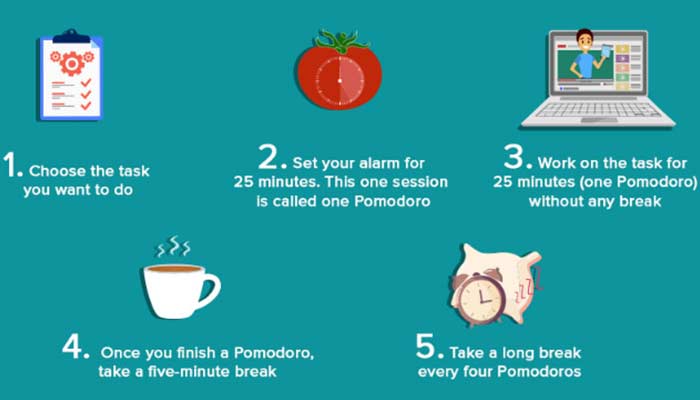
The Pomodoro Technique is a time management strategy that has completely changed how people think about concentration and productivity. This method that was created by Francesco Cirillo in the late 1980s, places a strong emphasis on regular breaks and planned work intervals to improve concentration, productivity, and efficiency.
People can greatly enhance their capacity to manage tasks, lessen burnout, and do more work in less time by grasping its tenets. This guide is a thorough explanation of the Pomodoro Technique’s key components and that why it is a vital time management technique.
1. Essential Elements of the Pomodoro Method
The following fundamental ideas are at the heart of the Pomodoro Technique.
Work in Focused Intervals
This technique entails doing a single activity for 25 minutes or a “Pomodoro” and then taking a 5-minutes rest. This method promises that you focus entirely on a single activity at a time.
Take Regular Breaks
It is advised to take a lengthier rest of 15 to 30 minutes following four Pomodoros in a row. Before returning to concentrated work, this break enables your mind to relax and rejuvenate.
Avoid Multitasking
This method promotes single-tasking which has been shown to be considerably more successful than attempting to multitask.
Track Progress
You can keep an eye on your output, spot trends, and make changes to increase efficiency by documenting each Pomodoro session.
Accept Imperfection
The time-boxing strategy forces you to prioritize progress above perfect outcomes which motivates you to begin activities without overanalyzing or aiming for perfection.
2. The Pomodoro Technique’s Advantages
The Pomodoro Technique is a productivity boost with quantifiable advantages that goes beyond time management.
Increased Focus
By focusing on a single task for 25 minutes, distractions are reduced, allowing for greater concentration and superior results.
Increased Productivity
By preventing overwork and ensuring steady progress, the structured intervals enable you to complete more tasks in less time.
Reduced Burnout
Regular breaks give your mind a chance to relax, preventing mental fatigue and maintaining long-term productivity.
Improved Time Awareness
By teaching you to gauge how long things will take, the method enables more practical time management and planning.
Stress Reduction
Stress is lessened and difficult jobs seem more bearable when one knows that a break is always imminent.
3. How Can the Pomodoro Technique Be Used?
The Pomodoro Technique is simple to use but discipline and consistency are key to success. The steps to follow are as given below.
Decide on Your Task
Decide on just one task to concentrate on. To prevent uncertainty, make sure that it is clear and actionable.
Establish a Timer
Set a timer for twenty-five minutes, it could be a dedicated Pomodoro tool, a smartphone app, or a physical timer.
Work Without Distractions
During the allotted 25 minutes, make a commitment to focusing solely on the selected task. Close tabs that aren’t needed, turn off notifications, and let people know when you won’t be available.
Take a Quick Break
Give yourself five minutes to relax once the timer goes off. Stretch, drink some water, or do anything soothing at this period.
Continue the Cycle
After finishing all four Pomodoros, take a lengthier 15 to 30 minutes rest to rehabilitate.
Modify as Necessary
Although 25 minutes is the typical time frame, you can experiment with shorter or longer intervals depending on the task’s requirements and your attention span.
4. Resources to Help With the Pomodoro Method
Numerous technological instruments are available to help in the effective application of the Pomodoro Technique. Among the most well-liked choices are the following.
Physical Timers
A concrete method of controlling your work intervals is to use a traditional kitchen timer or a particularly made Pomodoro timer.
Mobile Apps
Tracking Pomodoros and breaks while on the go is made simple by apps like Focus Keeper, Forest, and TomatoTimer.
Desktop Tools
Toggl Track, Clockify, and browser-specific Pomodoro plugins are examples of software that facilitates smooth integration with your digital workspace.
Productivity Journals
Recording finished Pomodoros in a paper or electronic journal incorporates accountability and progress monitoring.
5. Typical Obstacles and How to Get Past Them
Despite its simplicity, the Pomodoro Technique can present several difficulties when used. This is how to deal with them.
Interruptions
Your Pomodoro Technique might be interrupted, to reduce interruptions, let coworkers know how you work, establish limits, and turn off notifications.
Task Overload
To accommodate several Pomodoros, divide tasks into smaller, easier-to-manage components if they take longer than anticipated.
Inconsistent Breaks
Prolonged breaks can hinder work. To make sure you go back to work on time, set a timer for your breaks.
Getting Used to the Timer
At first, maintaining 25-minutes intervals would feel strange. Allow yourself time to get used to the new routine.
Procrastination
Begin modestly. To gain momentum and get past the procrastination inertia, start with one or two Pomodoros per day.
6. Who Can Benefit from the Pomodoro Technique?
The Pomodoro Technique’s universality is what makes it so lovely. Here are some instances of those who stand to gain a great deal from this approach.
Students
The method assists students in concentrating on finishing homework, preparing for tests, and handling their academic workload.
Professionals
By implementing Pomodoro sessions into the workdays, employees can enhance task management, fulfill deadlines, and prevent burnout.
Independent Contractors
Freelancers can utilize Pomodoros to track billable hours and establish structure without a set plan.
Creatives
The method can help authors, designers, and artists get beyond creative obstacles and continue producing work on a regular basis.
Home Based Workers
This approach promotes balance for individuals who work remotely by clearly defining the boundaries between work and leisure time.
7. Advice for Getting the Most Out of the Pomodoro Technique
Use the following methods to get the most out of the Pomodoro Technique.
Prioritize Tasks
Determine which tasks require attention by using a to-do list. The most important or urgent ones should come first.
Get Your Surroundings Ready
Before beginning a Pomodoro, make sure your desk is tidy and distraction-free.
Mix With Other Techniques
For increased productivity, combine the Pomodoro Technique with time-blocking or the Eisenhower Matrix.
Celebrate Milestones
To keep yourself motivated, treat yourself after finishing important activities or reaching a particular number of Pomodoros.
Reflect and Improve
Evaluate your development on a regular basis and pinpoint places where the method might be adjusted to better meet your requirements.
8. Pomodoro Technique’s Unique Features
The simplicity and versatility of the Pomodoro Technique are its main advantages. The Pomodoro Technique is simple, making it suitable for both novices and seasoned professionals, in contrast to other productivity strategies that could necessitate intensive preparation or tracking.
Its focus on balance, achieved through planned work and frequent breaks, addresses mental health and productivity, ensuring sustainability. The technique removes the chaos of multitasking by concentrating on a single activity at a time and each Pomodoro is completed with a sense of success. Its adaptability also makes it possible to customize it to fit a variety of tasks, objectives, and tastes.
One effective approach that helps people regain control over their time and energy is the Pomodoro Technique. You can achieve a new level of focus and productivity by adopting its single-tasking mindset, regular breaks, and planned intervals.
The Pomodoro Technique is a straightforward yet effective method for reaching your objectives, regardless of whether you are a professional, student, or someone looking to increase your own productivity. If you dedicate yourself to learning this method, you’ll see the significant influence it can have on your productivity, creativity, and general well-being.

Leave a Reply